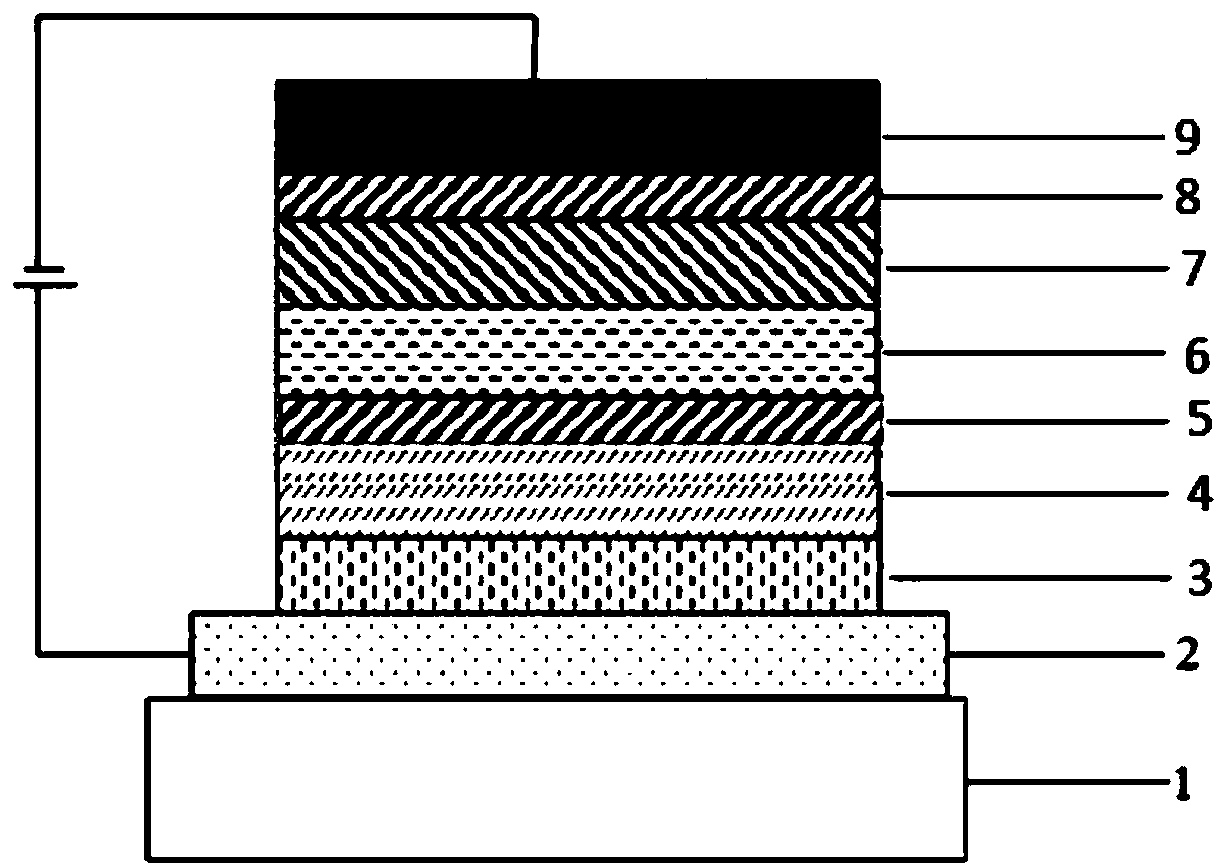Boron-containing organic electroluminescent compound and application thereof on organic electroluminescent devices
An electroluminescence and compound technology, which is applied to boron-containing organic electroluminescence compounds and its application in organic electroluminescence devices, can solve the problem of difficult exciton utilization, high fluorescence radiation efficiency, low state radiation transition rate, problems such as large Stokes shift, to achieve the effect of small FWHM, enhanced thermally activated delayed fluorescence efficiency, and small Stokes shift
- Summary
- Abstract
- Description
- Claims
- Application Information
AI Technical Summary
Problems solved by technology
Method used
Image
Examples
preparation example Construction
[0067] Preparation of Intermediate C
[0068] Preparation of Intermediate C-1:
[0069]
[0070] In a 250mL three-neck flask, under nitrogen protection, 0.02mol raw material A-1, 0.06mol raw material B-1, 0.10mol sodium tert-butoxide, 0.4mmol Pd 2 (dba) 3 Add 0.4mmol tri-tert-butylphosphine into 150mL toluene, stir and mix, heat to 110°C-120°C, reflux for 12h-16h, take a sample point plate, it shows that there is no raw material A-1 remaining, and the reaction is complete; naturally cool to room temperature, Filtration, the filtrate was rotary evaporated under reduced pressure to no fraction, and passed through a neutral silica gel column to obtain intermediate C-1, with an HPLC purity of 99.61% and a yield of 87.1%; elemental analysis structure (molecular formula C 46 h 48 Cl 2 N 2 ): theoretical value C, 78.95; H, 6.91; Cl, 10.13; N, 4.00; test value: C, 78.96; H, 6.93; Cl, 10.14; N, 4.02. ESI-MS (m / z) (M+): The theoretical value is 698.32, and the measured valu...
preparation Embodiment 1
[0080] Preparation Example 1: Synthesis of Compound 1
[0081]
[0082] Under nitrogen protection, 10 mmol of intermediate C-1 was added to 10 mL of dry, deoxygenated toluene, and 10 ml of n-butyllithium hexane solution (2.5 mol / L) was added at -78 ° C under stirring conditions, and After slowly rising to room temperature, 25ml of boron trichloride in toluene (1mol / L) was added dropwise for reflux reaction for 6h, followed by the addition of 4mmol of AlCl 3 , Continue to reflux for 18h, then add 30mmol raw material D-1 and reflux for 12h. The solvent in the reaction mixture was removed by rotary evaporator, the residue was cooled to room temperature, and dry n-hexane was used as eluent for chromatographic column purification to obtain the target compound 1, HPLC purity: 99.64%, yield 68.7%. Elemental analysis structure (molecular formula C 52 h 51 B 2 N 3 ): theoretical value C, 84.44; H, 6.95; B, 2.92; N, 5.68; test value: C, 84.46; H, 6.97; B, 2.93; N, 5.69. ESI-MS ...
preparation Embodiment 2
[0083] Preparation Example 2: Synthesis of Compound 8
[0084]
[0085] The preparation method of compound 14 is the same as in Example 1, except that intermediate C-1 is replaced by intermediate C-2; elemental analysis structure (molecular formula C 52 h 51 B 2 N 3 ): theoretical value C, 84.44; H, 6.95; B, 2.92; N, 5.68; test value: C, 84.45; H, 6.98; B, 2.91; N, 5.70. ESI-MS (m / z) (M+): theoretical value 739.43, found value 739.47.
PUM
| Property | Measurement | Unit |
|---|---|---|
| Thickness | aaaaa | aaaaa |
Abstract
Description
Claims
Application Information
 Login to View More
Login to View More - R&D
- Intellectual Property
- Life Sciences
- Materials
- Tech Scout
- Unparalleled Data Quality
- Higher Quality Content
- 60% Fewer Hallucinations
Browse by: Latest US Patents, China's latest patents, Technical Efficacy Thesaurus, Application Domain, Technology Topic, Popular Technical Reports.
© 2025 PatSnap. All rights reserved.Legal|Privacy policy|Modern Slavery Act Transparency Statement|Sitemap|About US| Contact US: help@patsnap.com



